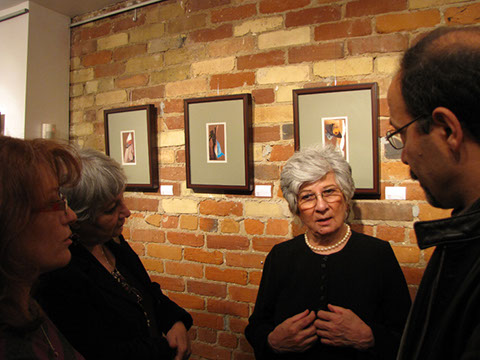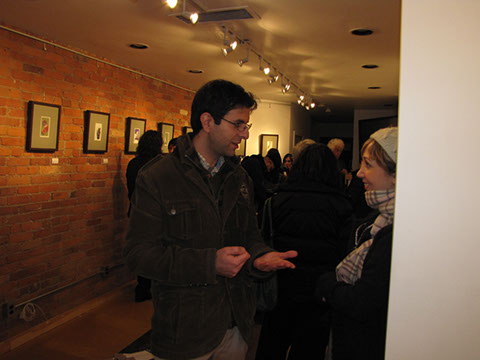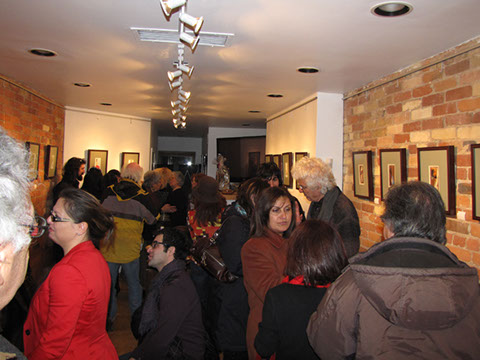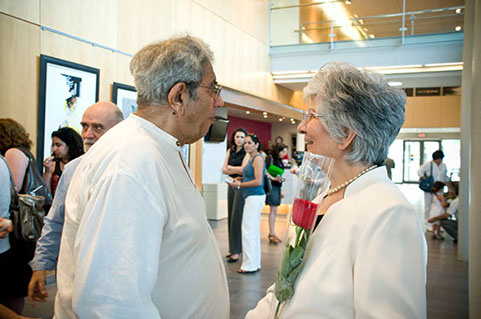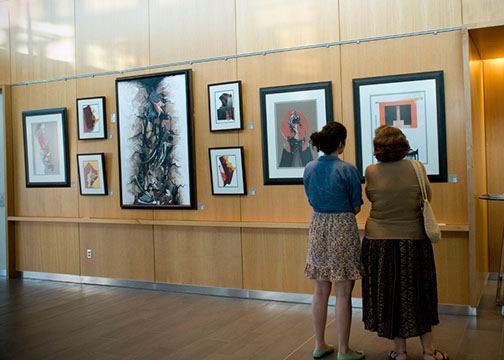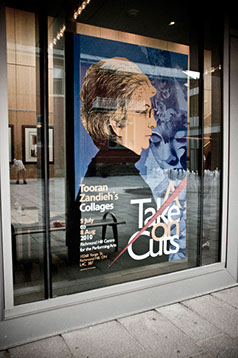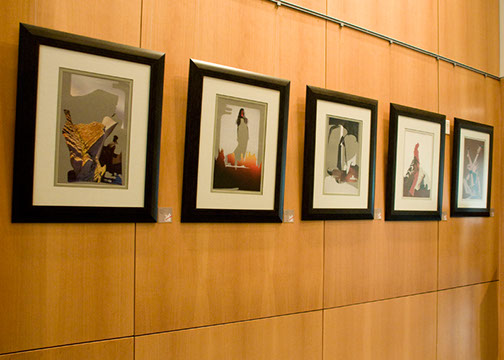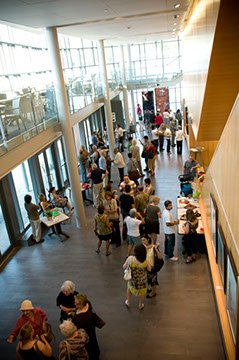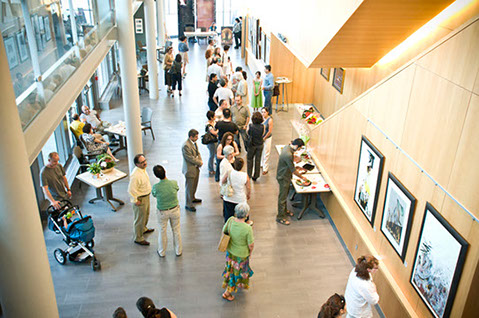Tooran Zandieh
Tooran Zandieh graduated with a Bachelor's degree in Fine Arts from Tehran University, Faculty of Fine Arts. Her professional experience includes over forty years of academic and professional experience in the field of art's education specializing in Arts and its integration with children's psychology. Zandieh has held more than fifteen international titles in art festivals for work achieved by her students with her direct guidance and supervision. She has been involved in various research projects along with several educational workshops for both children and their families on topics such as psychology, interpersonal skills and children-parents relationship. Zandieh has over forty-five years of experience as an art instructor in drawing, painting and art fundamentals in different universities and also in the "Centre for the Art's Education" in Tehran. Since 2002, she has started a new era in her artistic experiments with a unique technique called Collage. She discovered a new way of expressing her feelings and ideas by creating modern pieces of art out of pages that we review and read or watch everyday, but she looks at them in a mysterious and sometimes magical way.

Photo: Gordon Hawkins
BIO | CV
Tooran Zanieh was born 1940 Kermanshah, Iran
BFA 1964 Tehran University
Selected exhibitions
2016 Solo show, Art Square, Toronto, Canada
2015 Solo show, SA Gallery, Tehran , Iran
2014 Solo show, SA Gallery, Tehran , Iran
2013 Solo show, Iranian Artist Forum, Tehran, Iran
2012 Solo show, Elahe Gallery, Tehran, Iran
2011 Solo show, Hittite Gallery, Toronto
2010 A take on cuts, solo show, Richmond Hill Center of the performing arts
2009 Solo show, Queen Gallery, Toronto, Canada
2009 Solo show, Arta Gallery, Toronto, Canada
Several group shows in Tehran and Toronto, including
Arta Gallery, Queen Gallery, Visual arts group show for Tirgan Iranian festival at Harbor Front
Artist Statement
… My beloved mother used to sew “Chehel Tekeh” which literally means 40 pieces;
the closest translation for it is Patchwork. I grew up to love this art form. As an
educator of forty years, collage was always part of the pedagogical curriculum for
my students of all ages particularly the youth. I had learned that to make collage
means to think deep and to have perseverance. These were teaching goals that my
students and I achieved with great success while making collages. After retiring at
age 62, I started to create collage as a skilled artist. Collage creation became my only
way of expressing myself while utilizing my life experiences, education, and vision
for a better world.
Rather than using fabric in my “Chehel Tekeh”, I mainly use photographs. My work
starts by looking through journals, magazines, and books with high quality paper
and color. Collecting images from these sources is quite meditative. At times I do not
even feel the movement of the scissor in my hand cutting out photographs as if I am
in a trans. Before I even start assembling a collage, images pileup on my desk as
various sketches form in my head. Then I organize the cutup images into various
categories. The composition of a collage starts by choosing a photograph out of
these piles, and then another and another, … till I feel the composition is complete.
At this point, I start to affix the composed images on paper. The collage is done: a
silent meditation, a montage.
Often I tear up or burst into laughter looking at the finalized work. Each collage is a
page in my personal history as a woman, a wife, a mother, a grandmother, a teacher,
and a citizen of the world. Over fifty years of family life and community work,
struggles and triumphs, social pains and prevails, all are embedded in each and
every collage. None of my works have titles since I feel words limits the reach of the
piece. Each collage is an assemblage of many stories, diverse cultures, bumpy roads,
and community life. I rather have the audience interact with the piece as their own
experiences and feelings guide them. Even I cannot reproduce any of the collages as
its impossible to trace back where I got the images or how my mind and soul
directed my hands and eyes.
Interviews and Reviews
http://www.shahrvand.com/archives/78706
Collage and Tooran Zandieh | Reza Baraheni Poet, Novelist, Former President of Pen Canada
I read somewhere that a male sora shaman , treating a beautiful woman who had lost her husband, told her that the spirit of the husband was speaking to her through him and he was extremely nostalgic for her. But he had been reduced to pieces of bones in a pile of ashes. A metamorphosis had to take place. The spirit of the dead husband was undergoing transmigration. The pieces were gathering together in a new body with a new face. And the new man was on the way to her. When he arrived, she would recognize in him a love that would equal the lost one. The man arrived, he proposed to her, and marriage was consummated.
The meditation taking place in the magical collages of Tooran Zandieh is the artistic equivalent of this specific brand of amorous adventure. However, there are two main differences, and perhaps a third trailing them. In her case the woman is also dead, and the shaman will have to think of a replacement for her. The second difference is that the shaman is not male, but a shamanka, a female shaman , and the love-certainly a different kind of love – is taking place between two opposing polarities. Yet there is another difference. The kind of amorous adventure Tooran Zandiyeh is dealing with has nothing to do with real human beings. This is a categorical difference. We cannot get the meaning of the difference involved until we postpone our understanding for a few minutes. This difference requires a deferral, a postponement. You have to take your time to realize that neither men, nor women are real. In spite of the artistic and imaginative irregularity, certainly no transgressional illegality whatsoever is involved ., and if there is any perversion, it is because it is an art based on the ritual of dismemberment on one hand and the trailing revival of the dead on the other.
In other words, it is shamanistic in a different way. Every particle is both hidden and in the open. Everyone is looking at everything in the world, but they are not in a position to recognize that all things in the world could exist in other places as well: they could easily belong to new fields of bodies, new spaces of bones, flash, colours, shoulders, hands and eyes. This female shaman is involved in creating bodies and objects out of fragments she is harvesting from all over the world, and in all the possible colours and forms of the world. At this first stage of things, she has nothing but fragments. She handles them with care, like a mother handling different parts of the soft body of an unborn baby in her imagination, without the child actually being there. Then she ( Tooran , the artist , not the mother ) measures things with all the care of the world , a magical care , accompanied with female softness , unequalled gentleness and consistent affection and dedication addressing in full concentration the material. Because each piece is going to arrive in the right time and stand in the right place by the next piece and other next pieces, and together they are going to make other wholes, or rather whole entities that had been utterly nonexistent before. And the last stage of things: a blinding caressing of the eyes by colours and shapes, gathered together on the spatial feast of femininity, creating a kind Mallarmean “ espacement “ with no precedents in the art of collage. A woman cutting the world into pieces, pasting the pieces together, entering an unregitered nomenclature of shapes, colours, spacious and unmapped geography of dreams and deliriums. The question finally is how could absolutely hitherto scattered and dismembered pieces of humans and things revive themselves by letting themselves be delivered into structural amalgamations of awe and consternation, claiming for themselves a place and a name none other than the territory of genuine art, making the aboriginal displace and overtake the original?
Here you have a woman, returning to the space of the pure love of art. Only a female shaman, a shamanka, could carry on her shoulders such a towering beauty of shapes, colours and spaces, built of the collective participation of pieces from all the world of beauty, bridging the precipice of our jouissance, our unfathomable ecstasy, and our unquenchable thirst for more of the same courage.
An Interview by: Nasrin Almasi
Managing Editor of Shahrvand Newspaper
N.A.: I knew Tooran Nami as a devoted wife, a kind mother and a capable teacher. But she, in her private life and away from personal benefits, has been busy collecting experiences throughout her engaged passionate life, awaiting her own turn as a painter artist, what she achieved. She puts together.
Her installations to narrate the long-existing story of “woman’santicipation”.
She creates a world of eye caressing colors and invites the mind to contemplate.
N.A.
Asks about Tooran Zandieh’s life:
T.Z.:
I lived a simple fruitful childhood filled with love thanks to my mother, my father whom I lost very young, and my brother. They taught me to grow compassionate. It would not be possible to deprive my family from the attributes I had in me, I wanted to be a good mother. Well we can say that men are also adult children who need care and protection.
Although Nami and I started our studies together and graduated from “Tehran faculty of fine arts” at the same time, but according to an unwritten and unmentioned contract, Nami got involved in arts and I got busy with the responsibilities of our family life. Being employed in the ministry of education as a full time teacher and tutoring arts, along with managing our housework, I couldn’t spare any time for myself. But humans mind is like a free bird that doesn’t know any boundaries. The environment we lived in, long years of teaching arts, research,
experience and study, facilitated the fling of the bird and helped it become prolific. In my opinion, teaching arts can change both teacher’s and the student’s life. It develops one’s ability to observe, to contemplate, to search and to purify the mind. Anyways, what each individual appreciates in arts depends on what his natural characteristic back ground is capable of absorbing. My nature is passionate about painting and this passion has been my major source of energy in teaching and in life.
Let’s move on ..... . When my husband and children got settled, by the end of my stay in my home country Iran to whom I owe a lot, I started out my installation works after 37 years of anticipation at the age of 62. In the same year in Canada, having more time and more peace while staying at my daughter’s, and encouraged by her unsparing
support, I pursued my work in a small scale.
N.A.:
Why did you choose installation to make the bird of your mind fly?
T.Z.:
during this long period of teaching, I always used a variety of collages to help develop my student’s thinking skills. To be honest, I never thought I could go back to do arts, I had this feeling that my hands could not respond to my mind. Considering my living conditions and the facilities in hand at the time, I chose to do collage because it was the natural response to what my mind required. I would sit cutting and cutting and cutting passionately in my privacy at my daughter’s house.
I always carry out my works without any pre-sketches. At these moments, I am immersed in a special state o mind and emotions, not being quite aware of how I put the pieces together. In the end, looking at the composition I’ve made, sometimes I feel like crying and sometimes I feel like flying about and showing it to every one around.
Once these senseless-looking pieces put together, they represent me, Tooran Zandieh, they represent a human being in all her aspects.
I have always been a positive person and have always been in love., I’ve been in love with human beings and the nature, I’ve been in love with the creator of all the beauty in the nature and in humans. It’s a pure simple love that makes me feel dependant of nothing but love.
N.A.
Asks Tooran Zandieh to close the interview with what she wishes to say
T.Z.:
Life-long earned experiences in teaching, close relationships with my students. Experiences back home and during immigration years and what I’ve read and heard, have brought me to this conclusion that even in western countries, woman are victims of pressure and
discrimination. Despite the legislative protective procedures undertaken to emancipate woman in these countries, the responsibilities of woman have only been multiplied in the society and in the family. A woman has to do every thing. I mean, woman, still keeping her traditional responsibilities, has been assigned to earn a remarkable part of the household income and to play her role in social and professional commitments which require her constant presence in the society. Whereas, man, keeping his traditional privileges has generously dedicated his traditional responsibilities to woman.
Freedom has certainly a price to be paid!
Translator: Ellie Sharifi
Video 1
Video 2
Interview from Artebox
http://www.artebox.ir/v1/index.php/visual-arts/200-tooran-zandiye
Opening at the Queen Street Gallery




Graphic posters from previous exhibitions







Richmond Hill Center for Art






The RICHMONDHILL center for the Performing Arts was home to an incredible art display by local artist TOORAN ZANDIEH during the month of July 2010: Our walls were filled with works of many sizes but all as vibrant as the next. What moved me the most about the work was the ability of Ms. Zandieh to convey the row emotion of the subjects in each work. I could look at the work and know what they central character of the works was feeling. Ms. Zandieh has an amazing gift to bring her people and her culture to life on canvas. MICHAEL GRIT Theater Manager
